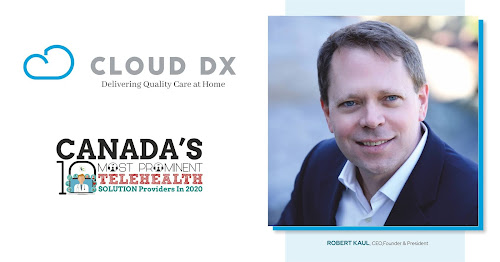People are scared to visit hospitals for other health checkups apart from the Covid-19 symptoms. The fear of being infected by the virus has helplessly occupied in peoples’ minds. People have started to reach out to doctors or hospitals through digital mediums for the care they need. Due to this, a drastic acceleration towards telehealth and virtual care can be seen in the healthcare industry.
Cloud DX is one prominent name among many telehealth solution providers in Canada. It has been a frontrunner in the telehealth industry. The company has incepted major modifications to the healthcare systems. It has introduced various new and innovative ways of treating patients remotely. It has also built confidence among patients and is thus ascending the zeniths of success.
Cloud DX founders Robert Kaul, Anthony Kaul and Dr. Sonny Kohli formed the company united by a vision to positively transform healthcare by reducing healthcare costs, by giving more people access to healthcare, and by making it easier for doctors to provide care and improve patient outcomes.
Through the below interview with the Cloud DX team, let us get to knowthe company from the inside.
Kindly brief us about the company.
As the healthcare industry rapidly moves to embrace telehealth, virtual care and remote patient monitoring at scale, Cloud DX is a first-mover in the race to combine clinical grade data collection with a consumer-friendly user experience.
Our mission is to create the worlds’ most effective, affordable, and easy to use digital solutions for virtual care, fully connected into modern healthcare systems to deliver superior results and improved patient outcomes.
Our value proposition is simple and powerful: more data + better data = better outcomes at lower cost.
What are the distinct products and services provided by the company, setting it apart from its competitors?
The Cloud DX Connected Health platform combines the best of telemedicine with remote vitals monitoring, patient surveys and smart notifications. It allows physicians, clinicians and care teams to virtually care for patients from hospital to home by automating monitoring of patient vitals including blood pressure, pulse rate, spO2, receive notifications should symptoms change, schedule a telehealth conference and implement pre-approved ‘action plans’ to help patients and their families proactively respond to changes in condition.
What are the key attributes that helped your company to overcome the challenges?
- Strong and accomplished leadership team
- Innovative product pipeline (vital sign detection, wearable monitors, cough analysis, medication detection, augmented reality)
- FDA and Health Canada approved products in market
- Strong alliances with healthcare providers, payers, advisors, and government organizations
What is the current scenario of Telehealth Solutions Providers Segment, from your point of view?
The COVID-19 global pandemic has dramatically accelerated the industry’s shift to telehealth and virtual care. Hospitals in virus hot-spot areas are stressed beyond capacity frontline healthcare workers are dying in unacceptable numbers.
Management of chronic illnesses accounted for more than 75% of worldwide healthcare costs in 2016, with heart disease (CHF), stroke and chronic obstructive pulmonary disease (COPD) named the top 3 global causes of mortality by the World Health Organization
1 In 2016, CHF and COPD combined claimed 12.5 million lives around the world, or 22% of all deaths that year. These illnesses cost more, and take more lives, than all cancers put together. Chronically ill individuals are among the most vulnerable populations to the COVID-19 virus.
The answer is virtual care – keep patients away from hospitals. According to a recent report by Deloitte:
Fifty percent of executives believe at least a quarter of all outpatient care, preventive care, long-term care, and well-being services would move to virtual delivery by 2040.
Three out of four executives predict that industrywide investments in virtual health would be significantly higher (more than 25 percent) over the next decade than today.
94% expect that next-generation data and interoperability solutions will enable widespread data sharing; and 88 percent of executives predicted wearable devices will be integrated with care delivery, resulting in a more tailored, personalized virtual health experience for consumers.
About two-thirds of surveyed executives thought that removing regulatory and payment barriers would accelerate virtual health adoption.
Cloud DX Connected Health Kits, remote patient monitoring and doctor-approved Action Plans allow patients and clinicians to intervene early to avoid exacerbations due to COPD and CHF – improving outcomes for these patients. Our platform has been clinically proven to reduce hospitalizations due to COPD exacerbation by 80%, and emergency room visits by 36%.
We believe that the use of virtual care solutions encompassing remote patient monitoring and telehealth in the management of COVID-19+ve patient, post-surgical patients and management can substantially reduce hospital re-admission numbers, improve hospitals capacity to do more elective and urgent surgeries, improve outcomes for the chronically ill, and reduce the spread of COVID-19 by keeping people out of the hospital.
What are the benefits gained by your clients, what strategies you embrace to keep them engaged?
Healthcare provider clients of the Cloud DX Connected Health platform are realizing all the benefits outlined above. In addition, patients feel more empowered and in control of their condition through regular monitoring of their vitals. This improves engagement in personalized health plans including medication adherence, which itself is a multi-billion-dollar annual problem.
What would be your advice for the budding startups and entrepreneurs in the industry?
Be tenacious. Believe in your vision. Treat your customers like gold. Learn quickly from your failures and be quick to adapt.
Brief us about the company’s future perspectives.
Expect to see a robust product pipeline from Cloud DX expanding our platform of offerings, scale up of manufacturing to meet growing demand, aggressive expansion into the US market and broader integration with EMRs. exacerbation by 80%, and emergency room visits by 36%.”
Source - https://bit.ly/2EYP0lc Next Article - Maple

No comments:
Post a Comment